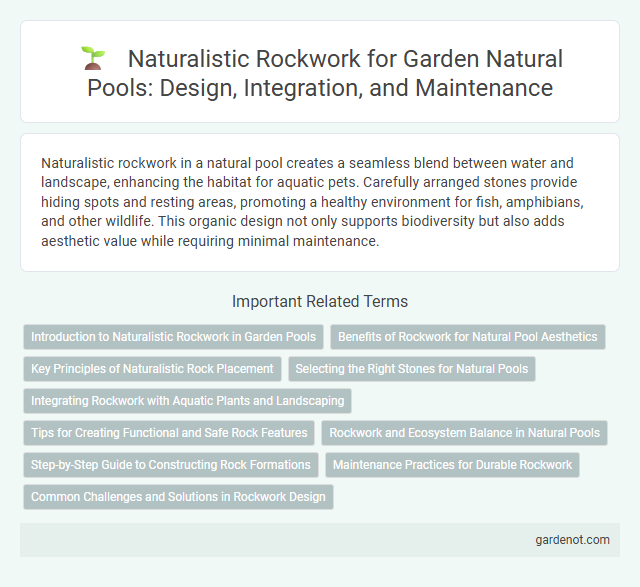Naturalistic rockwork in a natural pool creates a seamless blend between water and landscape, enhancing the habitat for aquatic pets. Carefully arranged stones provide hiding spots and resting areas, promoting a healthy environment for fish, amphibians, and other wildlife. This organic design not only supports biodiversity but also adds aesthetic value while requiring minimal maintenance.
Introduction to Naturalistic Rockwork in Garden Pools
Naturalistic rockwork in garden pools mimics the appearance of natural stone formations, enhancing both aesthetic appeal and ecological function. Using local stones, boulders, and carefully placed rocks, this technique creates seamless transitions between water and landscape, promoting habitat diversity. Proper installation ensures stability while maintaining natural water flow and supporting aquatic life.
Benefits of Rockwork for Natural Pool Aesthetics
Naturalistic rockwork enhances natural pool aesthetics by creating organic shapes and textures that seamlessly blend with surrounding landscapes, fostering a serene, earthy ambiance. Carefully designed rock formations provide natural filtration and water circulation benefits, improving water clarity and ecosystem balance. The integration of diverse stones and boulders not only supports aquatic plant growth but also offers habitats for beneficial microorganisms, contributing to a sustainable and visually captivating natural pool environment.
Key Principles of Naturalistic Rock Placement
Naturalistic rockwork in natural pools relies on the key principles of integrating rocks with the surrounding landscape, selecting varied rock sizes and shapes, and replicating natural erosion patterns to create authentic aesthetics. Proper rock placement enhances water flow, supports plant habitats, and ensures structural stability without visible unnatural alignments or symmetry. Emphasizing texture, color variation, and layering helps mimic natural geological formations, contributing to a seamless, organic pool environment.
Selecting the Right Stones for Natural Pools
Selecting the right stones for natural pools involves choosing materials that blend seamlessly with the landscape while ensuring durability and safety. Opt for smooth, non-porous stones like granite or basalt to prevent algae growth and maintain water clarity. Incorporate a variety of sizes and shapes to create naturalistic textures and enhance the pool's aesthetic appeal.
Integrating Rockwork with Aquatic Plants and Landscaping
Naturalistic rockwork in natural pools seamlessly integrates with aquatic plants and surrounding landscaping to create an organic and harmonious environment. Carefully selected rocks provide stable habitats for water-loving plants, enhancing biodiversity and promoting water clarity through natural filtration. Strategic placement of rock formations along the pool edges supports lush plant growth, stabilizes soil, and blends the water feature into the landscape for a serene, eco-friendly oasis.
Tips for Creating Functional and Safe Rock Features
Design naturalistic rockwork in a natural pool by selecting durable, non-toxic stones that blend seamlessly with the environment. Ensure all rock edges are smoothed and securely anchored to prevent slips and injuries, while incorporating gradual slopes for safe entry and exit points. Regularly inspect and maintain rock surfaces to avoid algae buildup, enhancing both safety and aesthetic appeal.
Rockwork and Ecosystem Balance in Natural Pools
Naturalistic rockwork in natural pools creates a stable habitat that supports diverse aquatic and terrestrial species, promoting ecosystem balance. Strategically placed rocks enhance water filtration and oxygenation, contributing to cleaner water and healthier aquatic flora and fauna. This integration of natural stone ensures structural integrity while fostering biodiversity essential for a self-sustaining natural pool environment.
Step-by-Step Guide to Constructing Rock Formations
Constructing naturalistic rockwork for a natural pool involves selecting durable, weather-resistant stones that blend seamlessly with the environment. Begin by designing a stable base using compacted soil and gravel, then layer larger rocks strategically to form foundational structures, ensuring each stone fits securely to prevent shifting. Finish by incorporating smaller stones and volcanic rock to create realistic textures and integrate aquatic plants for a harmonious, natural appearance.
Maintenance Practices for Durable Rockwork
Naturalistic rockwork in a natural pool requires regular inspection to identify and repair cracks or loose stones, preventing water leakage and structural damage. Applying sealants specifically designed for outdoor stone surfaces enhances durability by protecting against weathering and algae growth. Routine cleaning with non-abrasive tools and environmentally safe solutions maintains the rock's natural appearance and integrity over time.
Common Challenges and Solutions in Rockwork Design
Naturalistic rockwork in natural pools often faces challenges such as structural instability, uneven surfaces, and water leakage. Effective solutions include using durable, weather-resistant materials, precise placement of rocks to ensure proper weight distribution, and incorporating natural sealants or waterproof membranes to prevent seepage. Careful integration with the pool's ecosystem supports both aesthetics and functionality, ensuring longevity and environmental harmony.
Naturalistic rockwork Infographic

 gardenot.com
gardenot.com